Part 1: Introduction –
Neutral, Fundamentals, and Character Archetypes
Neutral is an immensely complex subject that spans multiple
games. It is not a Melee-specific mechanic, which makes it very difficult for
most Melee players to learn. Contrary to what many players do (if not believe),
neutral is not limited to only reads or only spacing or only movement. It is
the combination of all of these, in addition to your move choice, positioning,
control over your aerial drift, execution, and everything else that is required
for a Melee player to get the first hit against a competent opponent. Neutral
is connected to the punish game – you can’t get to your combo unless you play neutral first. I suppose you could just
guess and flail blindly, as many choose to do, but this won’t get you very far.
The key to success in Melee is trying to understand the entire game – that means the connections between every piece of the
puzzle. In other words, turning your movement into opening hits and those hits
into the largest combo that you can manage. If you are prepared to put forth the
dedicated effort required, Melee will reward you like no other game can. If
you’re more of a spectator, TO, or anonymous Twitter user, we all have our part
to play. You do you. All I ask that you at least try to accept the possibility
of a complex mental game buried within what looks like a Nintendo children’s
game from 2001. And for those of you in the FGC reading this Smash kid’s
ramblings, I hope these entries help you to understand that Smash games, and
especially Melee, have more value than most fighting game players give them
credit for.
“Fundamentals” are a
bit of a nebulous subject. The word means more in the context of Melee than it
does for most fighting games, as no traditional fighters require you to learn
how to wavedash, l-cancel, dashdance, etc. This, I think, is one of the many
contributing factors as to why many Melee players spend their entire time
playing the game in the dark. For all of the similarities between the fighting
game genre and Smash that I like to spew on the Internet, it is very obviously true that
Smash has numerous unique aspects. That said, there are in fact many
similarities. As I've touched on before, the biggest keys to fundamentals – spacing,
timing, and adaptation – all remain. Being in the corner is extremely bad for
you, even though Smash features areas above, below, and to the sides of the
stage. Both Smash and traditional fighters are rich with the same concepts of
space control, movement, combos, mixups, etc. Once you have a solid base of
fundamentals, picking up a new fighting game and learning the rules of
engagement becomes immensely easier. Street Fighter focuses on spacing and
footsies, as the combos are often shorter and more reliant on “links” (combos
without cancelling one move into another) than their counterparts in “Capcom
vs” games or anime fighters. Speaking of, those games introduced airdashes, a
combo system where normals can be canceled into other normals, and sometimes
teams of characters. Smash breaks even more Street Fighter rules by adding
platforms, the ledge, the area offstage, DI, and many other mechanics. However,
that does not mean being able to read your opponent, adapt, space, or any other
fighting game fundamental cannot be applied to our
party-games-turned-competitive-fighters. In fact, those fundamentals actively
make you better very quickly and are necessary for competing at a high level. The best players of our game have learned and
refined these principles over a long period of time.
One very important reason for these similarities is Sakurai’s
own immense ability at playing fighting games at the time he was making Smash
64 and Melee. There’s plenty of evidence for this online, from him winning a
Street Fighter 2 tournament with around 100 entrants to him talking about his prowess
at execution in the arcades. In fact, one reason for him regretting how
competitive he made Melee – and he did make Melee with advanced players in mind – would be the time he mercilessly combo’d a young
couple who had no idea how to play fighting games. Though he would later come to regret these design decisions, he packed Smash 64 and Melee with many similar mechanics and
references to 2D fighters. Even the way grounded normals work in Smash callback to the light ("jabs"), medium ("tilts"), and heavy ("smashes") normals of Street Fighter. Another excellent example of the similarities between
these sister genres would be the subject of the first characters made in Smash
and Street Fighter – Mario and Ryu. I’ve touched on this in earlier entries on
this blog, but it suffices to say that the characters fill a similar archetype
as the balanced all-rounders from whom all other characters descend. While he
has many moves stemming from his original games, Mario also very clearly borrows many of
Ryu’s moves for Smash.
·
Fireball – Hadoken (forward smash also features
the Hadoken’s charging animation)
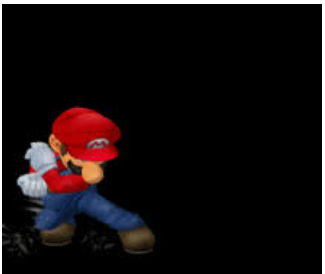
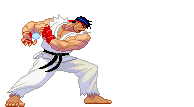
·
Super Jump Punch – Shoryuken (note the invincibility - Ryu introduced the invincible uppercut that remains standard in fighting games today and Mario's up-b is intangible from frames 3-6)
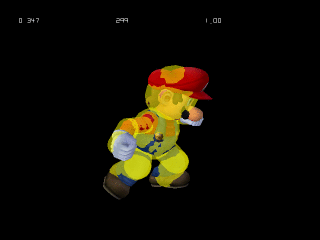
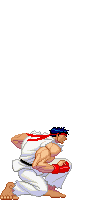
·
Mario Tornado – Tatsumaki Senpukyaku (Hurricane Kick),
mostly because they’re both spin moves that are used as movement options. They’re
also named for natural disasters, I guess?
Note also that these 3 special moves were the only specials Mario had in Smash 64. Ryu has only had 3 specials in every main series Street Fighter game besides SF3, where he gained the Joudan Sokutogeri, or Donkey Kick. Funny enough, Mario also gained a fourth special move in Melee – his cape.
Note also that these 3 special moves were the only specials Mario had in Smash 64. Ryu has only had 3 specials in every main series Street Fighter game besides SF3, where he gained the Joudan Sokutogeri, or Donkey Kick. Funny enough, Mario also gained a fourth special move in Melee – his cape.
·
Forward tilt – Standing medium kick

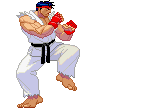
·
Up tilt – Crouching heavy punch (grounded normal anti-air uppercut with much less lag than the special move uppercut)
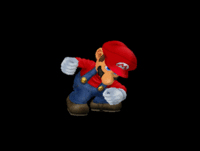
·
Forward-air – similar in both animation and
utility to Ryu’s forward+medium punch (punishes opponents for crouching; can
also be used like Ky’s Greed Sever to punish low normals)
Hopefully this section clears up some confusion as to why I constantly tout the similarities between these two characters.
Hopefully this section clears up some confusion as to why I constantly tout the similarities between these two characters.
Probably because fighting game players are forced to at least try to understand
the game they're playing, they tend to pick up the “Ryu” or “Ken” archetype of whichever
fighter they are currently starting to play. This is crucial because every
other character in the game builds on the all-rounders’ foundation as the first
characters at the beginning of development. Learning how to play as Mario comes
with learning how to play Melee, similar to how most fighting game players are
at least proficient as Ryu or Ken. I’ve been avoiding the subject of Luigi
because he is different from Mario in just about every conceivable way, relying
on his goofy wavedash and fall speed to get his hits. Still, he does like to be
in your face, mixing you up with his fast and tricky grounded movement to get
to his good combo game. I would still fit Luigi in the Ken archetype, as he
certainly has a lot of references to his Street Fighter counterpart – a worse
fireball than the original character, a better “tatsu” or spin move in the form
of his down-b, and most importantly, a fiery
uppercut used more often as a
damaging combo ender than as a reversal. These callbacks to Ken can be seen
most clearly in Smash 64, when Mario and Luigi were quite similar outside of a
few attributes and the aforementioned special move references. That said, Luigi
is obviously his own character, certainly the classic Nintendo little brother.
This reinforces my earlier point – Melee borrows a lot from traditional
fighting games despite being very unique. Blame Sakurai.
This may come as new information to the average Melee
player, but many fighting games share common archetypes like grapplers, zoners,
rushdown characters, and these balanced all-rounders, known as “shotos.” This
is a term that comes from Shotokan karate, the style Ryu and Ken take many of
their moves from. One of the shotos tends to be more defensive (Ryu) and one
tends to be more aggressive (Ken). In Guilty Gear, Ky Kiske serves as Ryu and
Sol Badguy as Ken. The characters are completely different, with movesets that
share little besides the typical fireball and uppercut special moves.
Nonetheless, they still fill the archetypes of balanced all-rounders. Ky would
like to stay at mid-range, throw fireballs, and rely on spacing. Sol would
rather go in and apply pressure. For those of you looking forward to the
upcoming Dragon Ball FighterZ (another reason I would encourage everyone to try
and learn how to play traditional fighters), Goku has been touted as the “Ryu”of the game, with Vegeta serving as his counterpart. Again, they are the
easy-execution all-rounders. Goku prefers to space and has the tools to keep
you at a distance in the form of his Kamehameha and fireballs ki blasts, whereas Vegeta prefers to go
in with his faster speed and variety of kicks. Similarly to how Melee features
numerous Nintendo characters with previously established moves, the Dragon Ball
universe does not lend itself easily to filling traditional fighting game
archetypes. Still, the same kind of people that enjoy Dhalsim in Street Fighter
might like Frieza in DBFZ or Marth in Melee, as all of those characters serve
as zoners. In other words, they like to keep you out and force you to approach.
Marth and Frieza, as a result of being in their respective games, obviously
have fantastic combo games that reward their players for getting a hit. Still,
in neutral it’s best to use Frieza’s variety of projectiles and Marth’s massive
disjoint to keep the opponent at a distance. To feed this into my point about
similarities between Smash and fighting games, picking your character is a very
good reflection of the kind of person you are. Characters often fill similar
roles across different rosters because these characters have to reach the same
kind of players. Fighting game devs, in other words, “read” the kind of person
that would want to play any given character and design them accordingly. In either genre, you can always
find a character that suits your particular play style.
Returning to the subject of fundamentals, learning them
through Melee can be all but impossible for the young, bright-eyed Smasher.
This is especially true in the current year, in the age of top player worship,
Twitch clips, and memes. Commentators often don’t have time in a 60 FPS game to
point out the minutiae of spacing and movement. They also lack the ability and/or
desire to learn how to read the minds of players competing at the highest
level. I mentioned this in a previous entry on this blog, but I didn’t even
hear about spacing or adaptation in the context of Smash until around a year after
my first tournament. Even now, the entire community seems to do nothing but
spew nonsense about “tech” and collectively circlejerk about the coolest combos
or upsets on Reddit. Most discussions about neutral took place on Smashboards
in the time before I was even a scrub. To most stereotypical “Smash kids” that
/r/Kappa and similar subsections of the wider fighting game community love to
make fun of, the subject of neutral has become unimportant. Many Melee guides
urge newer players to learn individual pieces of tech and optimize their
punishes because neutral is very difficult and comes simply from experience for
most. I reject this notion wholeheartedly. The ability to read your opponents,
to space using the infinite movement options given to you in Melee, and to
adapt are all skills that can be taught. They won't be found on the front page of /r/smashbros, however. Specifically, I urge you all to dive
into the wonderful world of fighting games. That’s how I learned. These games,
especially if you pick up a low-execution character, force you to learn how to
adapt. They make you learn how to space, how to read, and how to interact with your opponent. You should
never try to remove your opponent from the equation, as many Melee players choose
to.
If you want to begin playing 2D fighters, numerous resources exist online. The excellent Footsies Handbook, David Sirlin’s book Playing to Win, and Daigo Umehara’s The Will to Keep Winning all contain
wisdom that can be applied to Melee only if you have the necessary experience
in its sister genre. If you still don't want to get into traditional fighting games, at least try out Wobbles' incredible guide to neutral. In terms of game choice, I would recommend starting out with Ultra Street Fighter 4, which is a relatively simple and beginner-friendly game with a decent online community. Once you learn enough from that game, the latest Guilty Gear Xrd has incredible depth in addition to its fantastic soundtrack and stunning visuals. So far, this latest Guilty Gear has been the only video game besides Melee to inspire in me such a deep sense of wonder and desire to constantly learn more. Of course, you can eventually somehow discover the ability to interact on your
own, like the top players who have been playing for years. For those of you who want to actively learn how to interact with your opponent through the medium of video games, however, there's nothing better than learning how to fight on a 2D plane. I don’t mean to make
these games out to be only work, either. The rewards are immense and traditional fighters are simply very fun. There's a reason they've lasted this long in a gaming world that has trended more and more towards a casual audience. Gaining proficiency in fighting games is far easier than
it sounds, as well. Practice is important, but learning enough to pit your knowledge and
reflexes against an opponent of similar skill is a thrill that cannot be
simulated. Personally, I don’t practice my combos or setups very often in 2D
fighters. I don’t find practicing these games to be as fun as grinding things
in Melee or speedrunning Mario Sunshine, which takes up a lot of my time
nowadays. Instead, after putting in the legwork in the beginning, I went online
and to tournaments to pit my knowledge of fundamentals against real opponents.
Every match, win or lose, gives valuable experience and can teach you something new. Once
you begin to climb high enough on the mountain that is Melee, once you
understand what you and those around you are doing, that is when the real fun
begins. Don’t be like the Reddit scrub. Don’t be like the anonymous Twitter
egg. Don’t get stuck on false “plateaus” that really only come from your own
stubbornness and lack of the will to learn. To become better than the rest and
achieve victory over opponents far and wide, you need to understand their
habits, their spacing, and their patterns as well as their character and the
rest of the game that you’re playing. Understanding every aspect of the game is
crucial. The best players are so precise in placing their characters, spacing
around each other’s moves, turning their movement into hits, and everything
else that comes with the neutral game. I’d recommend watching any top player’s
analysis videos, as they often explain the complex decisions that go into their
play. These are all just some of the paths you have to the top. For some, it is
enough to look upward. But as I have said, if you’re prepared to get better, to
push yourself to be as good as you can be, Melee will make you feel absolutely
incredible.



No comments:
Post a Comment